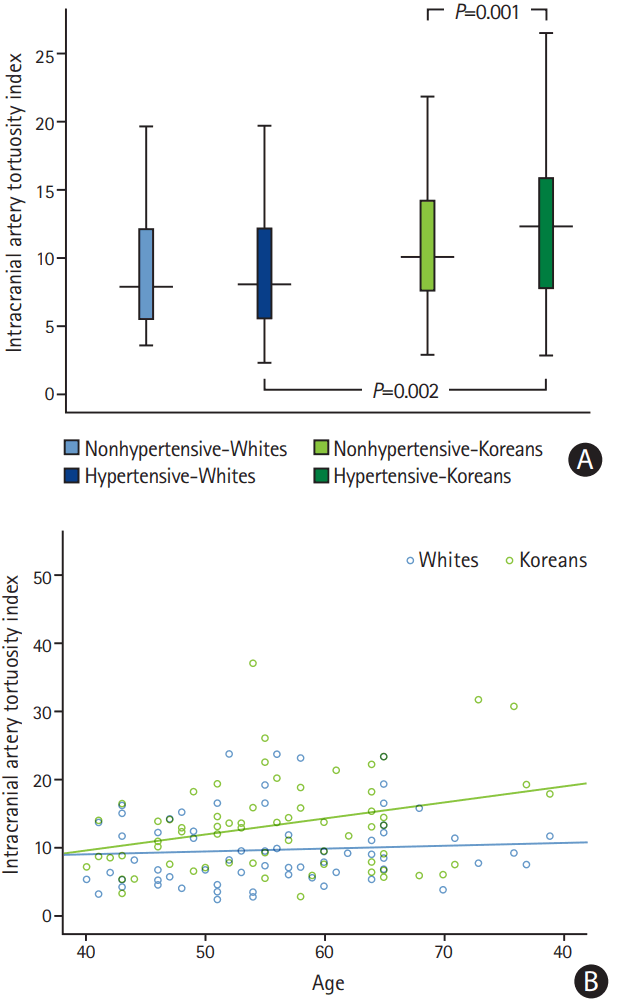Dear Sir:
It remains unclear why intracranial artery atherosclerosis (ICAS) is more common in Asians than in Caucasians [1,2]. Intracranial arterial tortuosity is associated with atherosclerotic plaque [3], and is greater in stroke patients with ICAS than in those without [4]. Therefore, we hypothesized that arterial tortuosity may be greater in Asians than in Caucasians, and compared the tortuosity between age-/sexmatched Koreans and Caucasians.
Among 339 “white-ethnicity” subjects who visited the Health Promotion Center at Kyung Hee University Medical Center from 2015 to 2016, we enrolled 76 without a history of stroke or cerebral artery steno-occlusion and performed magnetic resonance imaging (MRI) and magnetic resonance angiography (MRA). Controls included 76 age- and sexmatched Koreans from the same center. This study was approved by the local Institutional Review Board.
The source image of time-of-flight MRA obtained from a 3-T MRI system was used for measurement. The tortuosity of middle cerebral arteries (MCAs, M1 portion) and the basilar artery (BA) was measured semi-automatically using a commercial image analysis program (TeraRecon, TeraRecon Inc., San Mateo, CA, USA). Tortuosity was defined as the ratio between the actual length and the minimal straight length between the endpoints of each artery [4]. The intracranial artery tortuosity index (ICATI) was defined as the mean of the tortuosity indexes [(actual length/straight length−1)×100] of the right and left MCAs and BA.
Arterial tortuosity was significantly greater in the left MCA and BA, and marginally greater in the right MCA in Koreans than in whites (Table 1). The ICATI was higher in Koreans than in whites. Multiple logistic regression analysis including age, sex, risk factors, and ethnicity showed that high ICATI was independently associated with Korean ethnicity (odds ratio, 1.10; 95% confidence interval [CI], 1.03 to 1.17; P=0.002). ICATI was independently associated with age (β=0.214; 95% CI, 0.039 to 0.388; P=0.017) and hypertension (β=4.635; 95% CI, 1.255 to 8.014; P=0.008) in Koreans, but not in whites. ICATI was significantly higher in hypertensive Koreans than in non-hypertensive Koreans (16.5±9.9 vs. 10.8±4.5, P=0.001), whereas there was no such difference in whites (Figure 1A). ICATI was significantly higher in Koreans than in whites among hypertensive subjects (P=0.002), whereas there was no such difference in non-hypertensive subjects. ICATI increased with age in Koreans (correlation efficiency=0.340, P=0.003), but not in whites (Figure 1B).
We found that intracranial arterial tortuosity was greater in Koreans than in whites, and that Korean ethnicity was independently associated with tortuosity. However, this ethnic difference was not apparent among normotensive subjects. Intracranial arterial tortuosity was greater in hypertensive Koreans than in normotensive Koreans; this pattern was not observed in whites. Furthermore, the association of arterial tortuosity with old age and hypertension was observed in Koreans, but not in whites. Thus, intracranial arteries may be more vulnerably influenced by hemodynamic stress induced by age and hypertension in Koreans than in whites. The greater intracranial arterial tortuosity in Koreans with vascular risk factors may in part explain the higher prevalence of ICAS in Asians than in whites. Further studies are required to prove these preliminary findings.










